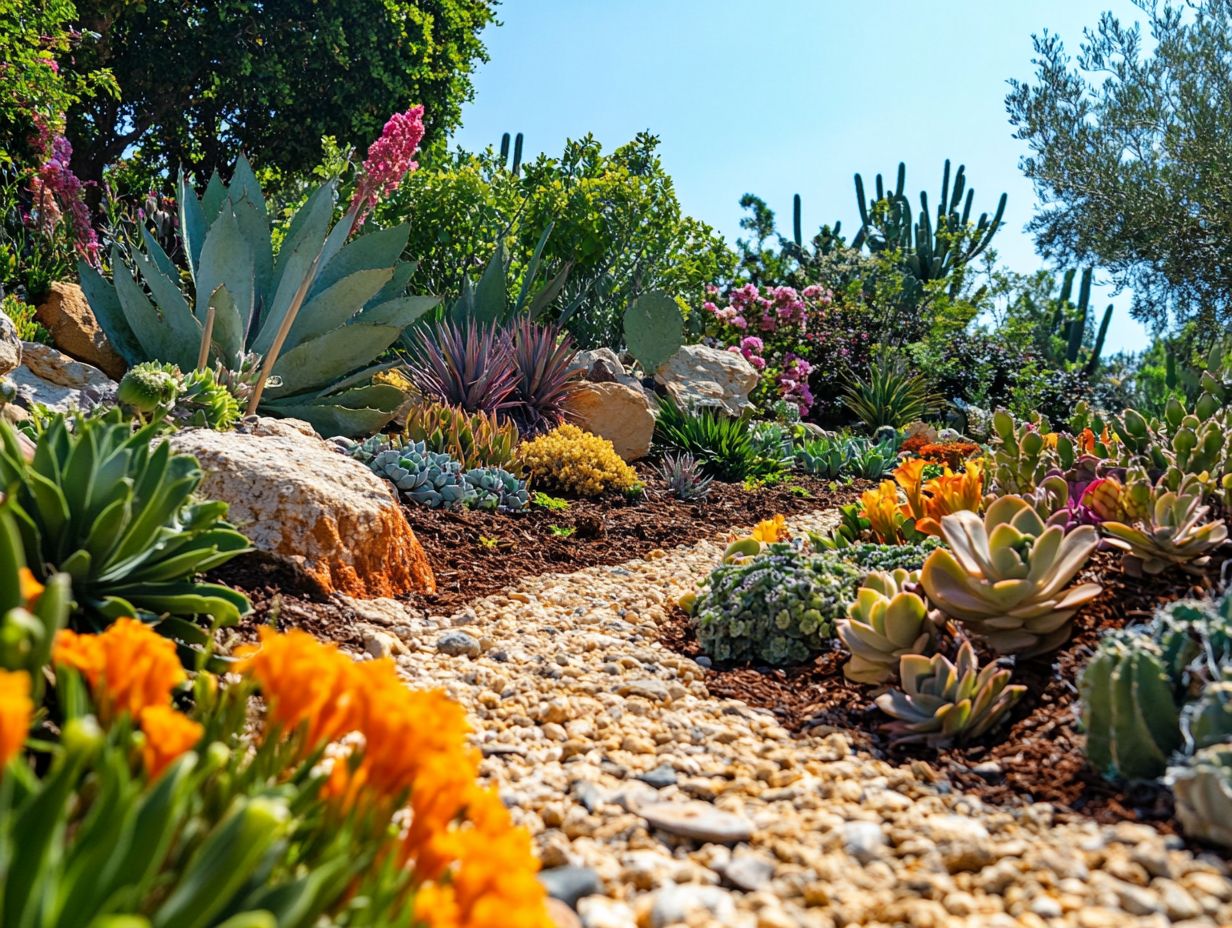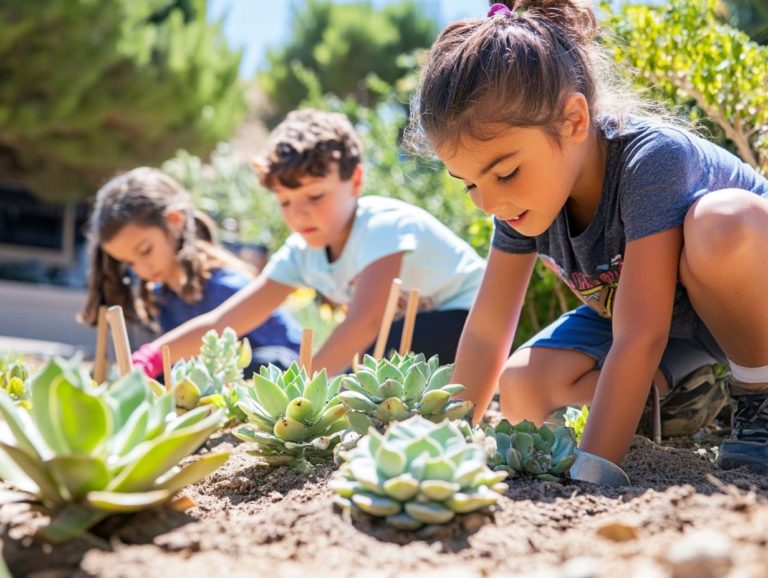The Importance of Drought-Resistant Plants in Landscaping
As climate change continues to shape our environment, the urgency for sustainable landscaping solutions becomes increasingly apparent.
Drought-resistant plants present a vibrant, eco-friendly alternative to traditional gardening, allowing you to conserve water while enhancing the beauty of your outdoor space.
This article delves into the essentials of drought-resistant plants, highlighting their unique characteristics and benefits. It also guides you in selecting the right varieties for your landscape.
You ll find effective design strategies, maintenance tips, and insights into the broader environmental and economic advantages of integrating these resilient plants into your home. Dive in to discover how you can create a stunning, low-water garden!
Contents
- Key Takeaways:
- Understanding Drought-Resistant Plants
- Choosing the Right Drought-Resistant Plants for Your Landscape
- Designing a Drought-Resistant Landscape
- How to Care for Your Drought-Resistant Plants
- Other Benefits of Using Drought-Resistant Plants
- Frequently Asked Questions
- What are drought-resistant plants and why are they important in landscaping?
- How do drought-resistant plants benefit the environment?
- What are some examples of popular drought-resistant plants for landscaping?
- Can drought-resistant plants still provide aesthetic appeal in a landscape?
- How do I care for drought-resistant plants in my landscaping?
- What are the long-term benefits of using drought-resistant plants in your yard?
Key Takeaways:

- Drought-resistant plants survive in dry conditions, making them ideal for sustainable landscaping.
- Consider water availability, sunlight, and soil for successful growth of drought-resistant plants.
- These plants conserve water and offer environmental benefits like reduced erosion and improved air quality.
Understanding Drought-Resistant Plants
Drought-resistant plants are crucial for anyone wanting a sustainable garden, especially in dry regions where saving water is key. Understanding the role of drought-resistant plants in landscaping can make a significant difference.
These resilient plants have developed remarkable unique adaptations that allow them to flourish in low-water conditions while promoting environmental sustainability. Their significance becomes even more pronounced in the context of climate change, as they enhance biodiversity and help preserve soil quality through deep root systems and moisture retention.
By incorporating these plants into your outdoor space, you can achieve breathtaking landscapes that require less maintenance and offer aesthetic charm.
What are Drought-Resistant Plants?
Drought-resistant plants are fascinating species specifically adapted to flourish in conditions where water is scarce. Their deep root systems and distinct water-saving features allow them to thrive in arid landscapes, making them perfect for landscaping that conserves water.
Take the Texas Ranger, for instance. With its striking silver-gray foliage, it easily endures prolonged dry spells by storing moisture in its leaves. Then there s the Joshua Tree, an iconic emblem of the Mojave Desert, boasting an extensive root system that plunges deep into the soil to tap into underground water reserves.
Don t overlook the Fairy Duster, either. With its charming pink flowers, it employs clever adaptations like a reduced leaf surface area and sunken stomata to minimize water loss during the hottest hours of the day.
Together, these remarkable species showcase how drought-resistant plants have evolved extraordinary physiological traits, allowing them to thrive in the toughest environments.
Benefits of Using Drought-Resistant Plants in Landscaping
Using drought-resistant plants in your garden brings many benefits. They save water, need less maintenance, and support a healthier environment. These resilient plants flourish in low-water conditions and play a vital role in promoting biodiversity by attracting pollinators (like bees and butterflies).
You ll find that these plants can elevate the visual appeal of your outdoor spaces, showcasing stunning blooms in a dazzling array of vibrant colors. For example, plants like lavender and salvia not only tolerate drought but also emit fragrant flowers that entice pollinators, creating a lively atmosphere.
Beyond their aesthetic charm, these plants contribute to improving soil quality by reducing erosion and enhancing nutrient retention. By incorporating drought-resistant varieties, you can cultivate a lush, sustainable landscape that supports local wildlife while requiring minimal care and resources, leading to a more resilient and thriving environment.
Choosing the Right Drought-Resistant Plants for Your Landscape

When selecting the perfect drought-resistant plants for your landscape, consider essential factors that elevate the beauty and sustainability of your outdoor space. Understanding why choose drought-resistant plants can help you pay attention to soil quality, local climate conditions, and the unique adaptations of different species.
This thoughtful approach ensures your plants thrive while contributing meaningfully to water conservation efforts.
Factors to Consider
You must consider key factors when choosing drought-resistant plants, including soil quality and local climate. Understanding how well your soil retains moisture and the need for effective irrigation systems can help you make informed plant selections that promote sustainability.
The composition of your soil is critical in determining which plants flourish; some species thrive in sandy soils, while others prefer clay or loamy conditions. Local climate conditions such as temperature extremes, rainfall patterns, and sunlight exposure must also be considered to select plants that can withstand these stresses.
An efficient irrigation system significantly contributes to maintaining plant health. Whether you choose drip irrigation or rainwater harvesting, the goal is to maximize water efficiency. By considering these factors, you ll enhance the resilience of your drought-resistant plants, making them more effective at conserving water and supporting your local ecosystem.
Designing a Drought-Resistant Landscape
Creating a drought-resistant landscape is an exciting challenge that blends artistry with smart water use. This approach champions environmental sustainability and highlights the importance of native plants in drought areas, while opening the door to imaginative planter designs.
You can incorporate a diverse array of drought-resistant plants, each carefully selected to thrive in your garden’s unique conditions.
Strategies for Water Conservation
Implementing effective strategies for water conservation is crucial when designing a drought-resistant landscape. Focus on optimizing irrigation systems and enhancing moisture retention in the soil.
- Utilize organic matter and adopt sustainable landscaping practices to improve plant health while minimizing water usage.
- Incorporate drip irrigation systems to target the root zones of plants precisely, ensuring water delivery where it’s needed most.
- Mulching around your plants reduces evaporation from the soil and helps regulate temperature for better moisture retention.
- Opt for native and drought-resistant plant species to minimize your dependency on supplemental watering.
- Employ organic amendments like compost and biochar to enrich the soil and improve its moisture retention capabilities.
Together, these techniques contribute to a sustainable garden ecosystem, conserving precious water resources while promoting lush, healthy plant life.
How to Care for Your Drought-Resistant Plants

To maintain drought-resistant plants, adopt specific care practices that minimize maintenance costs while ensuring their health and vibrancy throughout the changing seasons.
Incorporating organic matter and employing appropriate watering techniques can significantly boost the resilience of these plants, enabling them to thrive in diverse environmental conditions.
Start planning your drought-resistant garden today and help conserve water in your community!
Best Practices for Care and Maintenance
Caring for drought-resistant plants can enhance your gardening experience. Following best practices reduces maintenance costs.
Consider enriching your soil with compost or well-rotted manure. Adding these improves soil structure and adds nutrients.
Mulch is a protective covering for the soil that helps retain moisture and reduces weeds. This is another smart move that significantly eases care for these hardy plants.
Timing your watering is key. Aim to water early in the morning or late in the evening to minimize evaporation, ensuring your plants soak up as much moisture as possible.
Grouping drought-resistant varieties together enhances visual appeal while simplifying your watering and maintenance routines. This strategy leads to lower costs and a thriving landscape that you’ll be proud to showcase.
Other Benefits of Using Drought-Resistant Plants
By opting for drought-resistant plants, you unlock a wealth of environmental and economic benefits. These plants not only enhance biodiversity but also improve atmospheric CO2 absorption.
Such advantages are vital in cultivating a sustainable future for your landscapes and communities, providing effective solutions in the changing climate.
Environmental and Economic Advantages
The benefits of drought-resistant plants go beyond just saving water; using native plants in drought landscapes significantly contributes to environmental sustainability and vibrant landscapes.
By thriving on minimal water, these plants help lower your utility bills and enhance the ecosystem by boosting biodiversity.
When you choose these resilient species, you’re conserving precious water resources, especially in drought-prone areas. Their deep-root systems improve soil structure, facilitate rainwater absorption, and help mitigate erosion.
Financially, you ll be amazed at how much you can save! These plants reduce maintenance needs and fertilizer usage. This dual benefit nurtures a healthier environment and promotes a cost-effective approach to gardening, allowing you to enjoy lush gardens without the hefty price tag associated with traditional landscaping methods.
Frequently Asked Questions

What are drought-resistant plants and why are they important in landscaping?
Drought-resistant plants are species that have adapted to survive in dry and arid conditions. They play a crucial role in landscaping, as they require less water and maintenance, making them a sustainable option. Understanding the role of drought-resistant plants in climate resilience further highlights their benefits.
How do drought-resistant plants benefit the environment?
Drought-resistant plants have deep root systems that help prevent erosion and improve soil health. They also require less water, reducing strain on local water resources and helping to conserve water for other uses.
What are some examples of popular drought-resistant plants for landscaping?
Succulents, cacti, lavender, yarrow, and Russian sage are all popular choices for drought-resistant plants in landscaping. If you’re looking for more information, check out the best drought-resistant plants. Native plants that are adapted to local climate conditions are also a great option.
Can drought-resistant plants still provide aesthetic appeal in a landscape?
Absolutely! Drought-resistant plants come in a variety of colors, textures, and sizes, making them versatile for any landscaping design. For those looking for the best options, consider the top 10 drought-resistant plants for landscaping. They can also attract pollinators and wildlife, adding beauty and biodiversity to your yard.
How do I care for drought-resistant plants in my landscaping?
Drought-resistant plants still require some maintenance, such as occasional watering and pruning, but they are generally low maintenance. It is important to choose the right plants for your specific climate and provide proper soil, light, and drainage conditions.
Start your own drought-resistant garden today and enjoy the benefits of a sustainable landscape!
What are the long-term benefits of using drought-resistant plants in your yard?
Drought-resistant plants save water and reduce costs. Additionally, using native plants in drought gardening can boost your property value and lower the need for pesticides and fertilizers.
These plants create a sustainable and resilient yard that can survive droughts and extreme weather.






